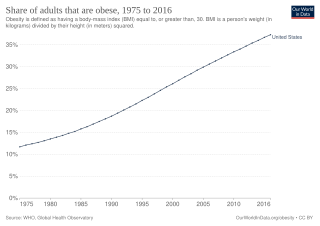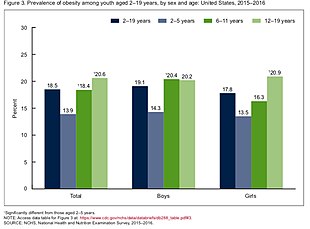
Youth is the time of life when one is young. The word, youth, can also mean the time between childhood and adulthood (maturity), but it can also refer to one's peak, in terms of health or the period of life known as being a young adult. Youth is also defined as "the appearance, freshness, vigor, spirit, etc., characteristic of one, who is young". Its definitions of a specific age range varies, as youth is not defined chronologically as a stage that can be tied to specific age ranges; nor can its end point be linked to specific activities, such as taking unpaid work, or having sexual relations.

Diseases of affluence, previously called diseases of rich people, is a term sometimes given to selected diseases and other health conditions which are commonly thought to be a result of increasing wealth in a society. Also referred to as the "Western disease" paradigm, these diseases are in contrast to so-called "diseases of poverty", which largely result from and contribute to human impoverishment. These diseases of affluence have vastly increased in prevalence since the end of World War II.

Childhood obesity is a condition where excess body fat negatively affects a child's health or well-being. As methods to determine body fat directly are difficult, the diagnosis of obesity is often based on BMI. Due to the rising prevalence of obesity in children and its many adverse health effects it is being recognized as a serious public health concern. The term 'overweight' rather than 'obese' is often used when discussing childhood obesity, as it is less stigmatizing, although the term 'overweight' can also refer to a different BMI category. The prevalence of childhood obesity is known to differ by sex and gender.
The epidemiology of autism is the study of the incidence and distribution of autism spectrum disorders (ASD). A 2022 systematic review of global prevalence of autism spectrum disorders found a median prevalence of 1% in children in studies published from 2012 to 2021, with a trend of increasing prevalence over time. However, the study's 1% figure may reflect an underestimate of prevalence in low- and middle-income countries.
Obesity in Mexico is a relatively recent phenomenon, having been widespread since the 1980s with the introduction of ultra-processed food into much of the Mexican food market. Prior to that, dietary issues were limited to under and malnutrition, which is still a problem in various parts of the country. Following trends already ongoing in other parts of the world, Mexicans have been foregoing the traditional Mexican diet high in whole grains, fruits, legumes and vegetables in favor of a diet with more animal products and ultra-processed foods. It has seen dietary energy intake and rates of overweight and obese people rise with seven out of ten at least overweight and a third clinically obese.
Chronic, non-communicable diseases account for an estimated 80% of total deaths and 70% of disability-adjusted life years (DALYs) lost in China. Cardiovascular diseases, chronic respiratory disease, and cancer are the leading causes of both death and of the burden of disease, and exposure to risk factors is high: more than 300 million men smoke cigarettes and 160 million adults are hypertensive, most of whom are not being treated. An obesity epidemic is imminent, with more than 20% of children aged 7–17 years in big cities now overweight or obese. Rates of death from chronic disease in middle-aged people are higher in China than in some high-income countries.

Obesity is common in the United States and is a major health issue associated with numerous diseases, specifically an increased risk of certain types of cancer, coronary artery disease, type 2 diabetes, stroke, and cardiovascular disease, as well as significant increases in early mortality and economic costs.

Obesity has been observed throughout human history. Many early depictions of the human form in art and sculpture appear obese. However, it was not until the 20th century that obesity became common — so much so that, in 1997, the World Health Organization (WHO) formally recognized obesity as a global epidemic and estimated that the worldwide prevalence of obesity has nearly tripled since 1975. Obesity is defined as having a body mass index (BMI) greater than or equal to 30 kg/m2, and in June 2013 the American Medical Association classified it as a disease.

Obesity in Canada is a growing health concern, which is "expected to surpass smoking as the leading cause of preventable morbidity and mortality" and represents a burden of Can$3.96 (US$3.04/€2.75) billion on the Canadian economy each year."

According to 2007 statistics from the World Health Organization (WHO), Australia has the third-highest prevalence of overweight adults in the English-speaking world. Obesity in Australia is an "epidemic" with "increasing frequency." The Medical Journal of Australia found that obesity in Australia more than doubled in the two decades preceding 2003, and the unprecedented rise in obesity has been compared to the same health crisis in America. The rise in obesity has been attributed to poor eating habits in the country closely related to the availability of fast food since the 1970s, sedentary lifestyles and a decrease in the labour workforce.

Obesity in the Middle East and North Africa is a notable health issue. Out of the fifteen fattest nations in the world as of 2014, 5 were located in the Middle East and North Africa region.
This article provides a global overview of the current trends and distribution of metabolic syndrome. Metabolic syndrome refers to a cluster of related risk factors for cardiovascular disease that includes abdominal obesity, diabetes, hypertension, and elevated cholesterol.
Childhood chronic illness refers to conditions in pediatric patients that are usually prolonged in duration, do not resolve on their own, and are associated with impairment or disability. The duration required for an illness to be defined as chronic is generally greater than 12 months, but this can vary, and some organizations define it by limitation of function rather than a length of time. Regardless of the exact length of duration, these types of conditions are different than acute, or short-lived, illnesses which resolve or can be cured. There are many definitions for what counts as a chronic condition. However, children with chronic illnesses will typically experience at least one of the following: limitation of functions relative to their age, disfigurement, dependency on medical technologies or medications, increased medical attention, and a need for modified educational arrangements.

Globally, an estimated 537 million adults are living with diabetes, according to 2019 data from the International Diabetes Federation. Diabetes was the 9th-leading cause of mortality globally in 2020, attributing to over 2 million deaths annually due to diabetes directly, and to kidney disease due to diabetes. The primary causes of type 2 diabetes is diet and physical activity, which can contribute to increased BMI, poor nutrition, hypertension, alcohol use and smoking, while genetics is also a factor. Diabetes prevalence is increasing rapidly; previous 2019 estimates put the number at 463 million people living with diabetes, with the distributions being equal between both sexes icidence peaking around age 55 years old. The number is projected to 643 million by 2030, or 7079 individuals per 100,000, with all regions around the world continue to rise. Type 2 diabetes makes up about 85-90% of all cases. Increases in the overall diabetes prevalence rates largely reflect an increase in risk factors for type 2, notably greater longevity and being overweight or obese. The prevalence of African Americans with diabetes is estimated to triple by 2050, while the prevalence of whites is estimated to double. The overall prevalence increases with age, with the largest increase in people over 65 years of age. The prevalence of diabetes in America is estimated to increase to 48.3 million by 2050.
Attention-Deficit/Hyperactivity Disorder (ADHD) is a neurodevelopmental disorder characterized by difficulty focusing attention, hyperactivity, and impulsive behavior. Treatments generally involve behavioral therapy and/or medications. ADHD is estimated to affect about 6 to 7 percent of people aged 18 and under when diagnosed via the DSM-IV criteria. When diagnosed via the ICD-10 criteria, hyperkinetic disorder gives rates between 1 and 2 percent in this age group.
Childhood obesity is defined as a body mass index (BMI) at or above the 96th percentile for children of the same age and sex. It can cause a variety of health problems, including high blood pressure, high cholesterol, heart disease, diabetes, breathing problems, sleeping problems, and joint problems later in life. Children who are obese are at a greater risk for social and psychological problems as well, such as peer victimization, increased levels of aggression, and low self-esteem. Many environmental and social factors have been shown to correlate with childhood obesity, and researchers are attempting to use this knowledge to help prevent and treat the condition. When implemented early, certain forms of behavioral and psychological treatment can help children regain and/or maintain a healthy weight.

Obesity and the environment aims to look at the different environmental factors that researchers worldwide have determined cause and perpetuate obesity. Obesity is a condition in which a person's weight is higher than what is considered healthy for their height, and is the leading cause of preventable death worldwide. Obesity can result from several factors such as poor nutritional choices, overeating, genetics, culture, and metabolism. Many diseases and health complications are associated with obesity. Worldwide, the rates of obesity have nearly tripled since 1975, leading health professionals to label the condition as a modern epidemic in most parts of the world. Current worldwide population estimates of obese adults are near 13%; overweight adults total approximately 39%.

Obesity in Thailand has been flagged as a major source of health concern, with 32% of the population identifying as overweight and 9% obese. With reference to 2016 data from the World Health Organization (WHO), Thailand has one of the highest incidence of overweight citizens in the South East Asian region, second to only Malaysia. The Thai National Health Examination Surveys (NHES) found that obesity in Thailand more than doubled during the period 1991-2014. This spike in obesity levels has been largely attributed to increased access to junk food, and unhealthy switches from active to sedentary lifestyles. These factors are closely linked to economic growth in the country.

According to the World Health Organization (2015), the "worldwide population of overweight and obese adults increased between 1980 and 2013 from 30 percent to 38 percent in women, and 29 percent to 37 percent in men". The prevalence of obesity continues to rise in all age groups in this developing country.












